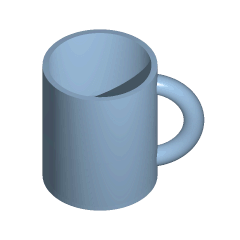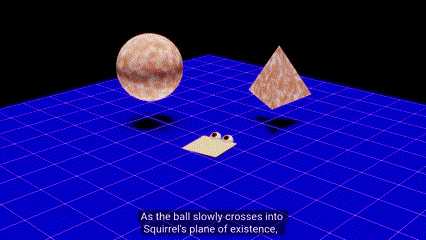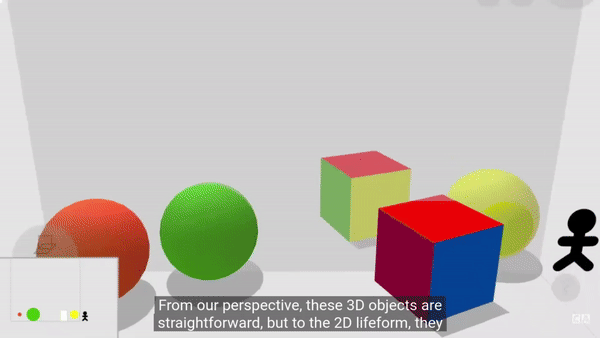
Example of topological equivalence.
Source: Mug and Torus morph, Lucas Vieira (Wikipedia).
A dimension, according to Oxford Languages, refers to a mode of linear extension which corresponds to a coordinate set specifying the position of a point. Different dimensions are the different coordinates required to specify a point in space. As we live in three-dimensional space, we require three coordinates to do so. Two-dimensional beings would require two, and so forth.

Example of topological equivalence.
Source: Mug and Torus morph, Lucas Vieira (Wikipedia).
Topology is a branch of mathematics concerning the properties of geometric objects that are "preserved through continuous deformations" (Wikipedia). For example, a shirt, no matter how you twist, crush, bend, stretch, or otherwise manipulate it (without opening, closing, tearing apart, stapling or gluing together any of its surface), will always have four openings. Therefore, to topologists, doughnuts are synonymous with coffee mugs — both have a single hole. (Holes are not loosely defined in topology, despite not having a big fancy name. Thus, the interior drinking portion of a mug is not considered a hole, merely a depression in the mug's surface, or a "divot".) We would say they are topologically equivalent.
A manifold is any topological surface that can exist in any dimension. For example, a 1D manifold would be a line, a 2D manifold would be a plane, and a 3D manifold would be a cube. But there are other shapes as well, like the circle (1D), the torus/doughnut (2D), and the tetrahedron (3D).
Orthogonal (in this context) means perpendicular. Typically it is defined as "of or involving right angles"/"at right angles" (Oxford Languages).
Extradimensional is a word whose meaning I have not confirmed with any dictionary and which I have been using frivolously to mean "of an unfamiliar amount of dimensions".
Some theorize that time is the fourth dimension; if true, it is a very simple one, since one can only move through it in one direction, at the same rate. (4D beings may be able to manipulate this property, or not follow it entirely, although us 3D beings must, but we'll get into that later.) Spatial dimensions, however, like the three we know and experience, can be traversed in all directions. (A dimension kind of is a direction.)
However, assuming time is not the fourth dimension, and that 4D exists as something other than a hypothetical, a fourth dimension of space is impossible to perceive or even visualize for us. So, in order to put this into perspective and give you some idea of what it must be like, we'll go a dimension lower, into two-dimensional existence.
Two-dimensional creatures do not understand spheres or cubes. They only know circles and squares. In order to perceive a sphere, such a creature (Bob) would have to view it one slice at a time in its 2D world.
Example:

Bob has a friend named Squirrel, who is featured in this depiction.
Source: Paradox of the Möbius Strip and Klein Bottle - A 4D Visualization, drew's campfire on YouTube (2022).
It seems obvious to us what a sphere is, but Bob would not be able to comprehend it unless it adapted to his 2D perspective so that he could properly view it — in other words, he cannot see the entire thing at once like we can. This is just like the nature of 4D. In order to understand all of a 4D object, we have to see it one slice at a time in our little 3D world in order to begin to understand all of it. Remember Cavalieri's observation from before? Well, these infinitely thin slices that Bob is seeing each occupy one single plane, since planes are 2D and he is also 2D.
Cubes are slightly more complicated than spheres, since spheres look the same no matter what angle you view it from. Bob has no concept of 3D rotation, so if a cube were to rotate along the third dimension, it would merely look as though it were shrinking and growing in odd ways, like so:

Bob's uncle Marley, utterly bamboozled by 3D objects.
Source: Simulating Biology in Other Dimensions, Curious Archive on YouTube (2023).
Although it seems obvious to us what is happening, the 2D entity is clueless. This is the case with us and 4D. It is a humbling experience, to realize we must seem like bumbling buffoons to 4D beings. Just as 2D must with 3D, we would have to see a sequence of slices in order to have some grasp of higher-dimensional shapes. Things existing in the fourth dimension have the capacity to become literally invisible to us.
The difference between 2D and 3D spheres: A 2D sphere is a two-dimensional manifold, as it exists only as a closed surface and, while it can be given shape/texture/etc, it still has no depth. 3D spheres have, well, interiors, and are known as balls. You can stick a pencil through a 3D sphere, but it will not go through a 2D sphere, since there is nothing inside of it and a pencil can't exist in 2D anyway. (A 2D pencil would be stuck on the sphere like a sticker, if the shape of the dimension were following the manifold.)
A 2D sphere has two "sides" (but no depth, because it is infinitely thin): the visible exterior and the interior, which is not visible unless you cut a hole in the manifold. Another way to put it is, 2D spheres aren't hollow balls floating in space. They are 2D manifolds, and there's no space around them or inside them. They exist within a singular plane. So, now that you're not confused, let's talk about embedding:
did u know that snow is 90% air (placeholder)
P.S. If you're looking for further resources, I highly recommend watching the two videos that I made GIFs out of. They're both put together quite excellently.